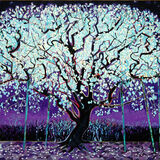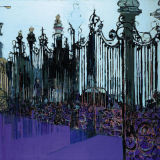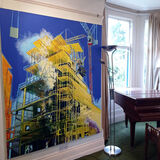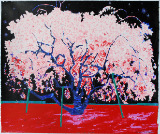Forest Ether
Simon McWilliams - Forest Ether 2020
Text by Dr. Dickon Hall
Text by Dr. Dickon Hall
Simon McWilliams is a highly independent artist, whose work is shaped above all by his absorption in paint and the significance of the painting process. For him, this medium itself is transformative and his work demonstrates that it can be a part of life as significant as the subject it describes, a continual assertion of the importance of painting and its unique attributes and possibilities.
Notably, when he discusses those artists whose work is meaningful to him their use of paint and the emphasis they place on its materiality is significant and he clearly finds a sense of shared integrity in their approach. McWilliams comes from a family of painters and remains conscious of these early influences but his responsiveness to a wide range of artists is invigorating.
His interest in certain subjects is primarily visual, a response to a stimulus from the real world that conveys a strong sense of its distinctive physical presence. In many ways his work defines an iconography of daily life within the contemporary, primarily urban experience, dealing with often unusual and innovative subjects. He has completed an extensive series of paintings inspired by buildings under construction in Belfast covered in scaffolding and netting, as well as painting palmhouses, wrought-iron gates and railings, greyhound tracks and tennis courts.
His decisions are in part driven by the potential a subject offers him to push further his use of paint and to introduce more abstract elements into an image, such as the patterns emerging in reflections seen in the glass of a Bond Street shop window, the movement of shadows beside wheelchair racers, an image inspired by watching a race on television, or the decorative arabesques of a chandelier. Concepts and ideas related to the subject often emerge as the paint begins to engage with it.
This interpretative power of paint is at the heart of Simon McWilliams’ art. He allows elements of chance to come into play, or transitory natural effects of shadow or light to be integrated within the permanent definition of the image, and colour to emerge as an expressive element rather than being used in a naturalistic manner. Conscious of the power of visual ambiguity and contrast, he brings together passages of movement and stillness, or representation and abstraction, into close alignment within a painting. Often a mark is made purely in reference to the paint surface rather than having any immediate imitative intentions.
McWilliams has constantly made technical experiments within the space of these works, introducing elements of collage, spraying and stencilling on to the canvas, exploring perspective, ultimately demonstrating the varied qualities of oil paint. He has explored the effect of expanding an image to fill the canvas, absorbing our attention within it and allowing the paint surface to become less imitative and more an expression of its materiality. In other works he has been interested in the crucial role the edges of a canvas can play, or even the suggestion of something significant beyond the canvas itself.
It is often at this point of technical concentration that the concept of a work can become more apparent. McWilliams is insistent that this never defines a painting, but he is aware of the suggestions and echoes of meanings, both personal and universal, that images carry with them. Often the act of painting itself becomes a metaphor, drawing attention to what is hidden and to the nature of concealment, or using a passage of painting to pin down a memory, such as children playing in snow. McWilliams’ reluctance to discuss meaning beyond technique and process belies his engagement with a number of issues, which become embedded within these series of works.
Painting remains, ultimately, a highly personal matter for McWilliams, marking an engagement with the world and the people around him through a medium that remains uniquely versatile. Even when his work appears most engaged with the man-made creations that dominate our cities and our world, his introduction of organic or human elements and the insistent assertion that paint can still control, break down and re-create these constructions, ensures that these are deeply human works.
Although he has previously made some paintings of flowers and vegetation, McWilliams’ most recent work concentrates on much more organic subjects, almost as a counterpart to the paintings of human construction and activity that have placed much of the natural world under threat. Although McWilliams has only ever used the image as a starting-point for an exploration in paint, in these recent works he draws more attention to the shift that takes place within a painting from the specific to the universal using, in this case, the image of the hothouse. Forest Ether uses intense colour and an ethereal mist between the plants and the dome to suggest the subject moving into an ambiguous territory between the real and the supernatural, with the collaged texture of leaves in the foreground both physically present and also somehow denying the illusion of the image. Another recent painting in this series, Hothouse 2020, suggests a vastness in scale that removes it from the everyday human experience to a more metaphorical existence, while still asserting our relationship as humans to the natural world around us.
The cherry tree has also been a recent subject for McWilliams, and one might see it as analogous to his attitude towards paint as a medium. It continues to flower even as the world around changes, adapting to its environment much as McWilliams has introduced new materials and new techniques into his latest works, affected by the enormous changes that have gone on around him. Yet as with art the cherry tree continues to provide something beautiful, revelatory and enduring.
Dickon Hall , Northern Ireland ,September 2020
Dickon Hall is an art historian and curator. He has written and lectured extensively on twentieth century and contemporary Irish art and published books on Colin Middleton and Nevill Johnson
Notably, when he discusses those artists whose work is meaningful to him their use of paint and the emphasis they place on its materiality is significant and he clearly finds a sense of shared integrity in their approach. McWilliams comes from a family of painters and remains conscious of these early influences but his responsiveness to a wide range of artists is invigorating.
His interest in certain subjects is primarily visual, a response to a stimulus from the real world that conveys a strong sense of its distinctive physical presence. In many ways his work defines an iconography of daily life within the contemporary, primarily urban experience, dealing with often unusual and innovative subjects. He has completed an extensive series of paintings inspired by buildings under construction in Belfast covered in scaffolding and netting, as well as painting palmhouses, wrought-iron gates and railings, greyhound tracks and tennis courts.
His decisions are in part driven by the potential a subject offers him to push further his use of paint and to introduce more abstract elements into an image, such as the patterns emerging in reflections seen in the glass of a Bond Street shop window, the movement of shadows beside wheelchair racers, an image inspired by watching a race on television, or the decorative arabesques of a chandelier. Concepts and ideas related to the subject often emerge as the paint begins to engage with it.
This interpretative power of paint is at the heart of Simon McWilliams’ art. He allows elements of chance to come into play, or transitory natural effects of shadow or light to be integrated within the permanent definition of the image, and colour to emerge as an expressive element rather than being used in a naturalistic manner. Conscious of the power of visual ambiguity and contrast, he brings together passages of movement and stillness, or representation and abstraction, into close alignment within a painting. Often a mark is made purely in reference to the paint surface rather than having any immediate imitative intentions.
McWilliams has constantly made technical experiments within the space of these works, introducing elements of collage, spraying and stencilling on to the canvas, exploring perspective, ultimately demonstrating the varied qualities of oil paint. He has explored the effect of expanding an image to fill the canvas, absorbing our attention within it and allowing the paint surface to become less imitative and more an expression of its materiality. In other works he has been interested in the crucial role the edges of a canvas can play, or even the suggestion of something significant beyond the canvas itself.
It is often at this point of technical concentration that the concept of a work can become more apparent. McWilliams is insistent that this never defines a painting, but he is aware of the suggestions and echoes of meanings, both personal and universal, that images carry with them. Often the act of painting itself becomes a metaphor, drawing attention to what is hidden and to the nature of concealment, or using a passage of painting to pin down a memory, such as children playing in snow. McWilliams’ reluctance to discuss meaning beyond technique and process belies his engagement with a number of issues, which become embedded within these series of works.
Painting remains, ultimately, a highly personal matter for McWilliams, marking an engagement with the world and the people around him through a medium that remains uniquely versatile. Even when his work appears most engaged with the man-made creations that dominate our cities and our world, his introduction of organic or human elements and the insistent assertion that paint can still control, break down and re-create these constructions, ensures that these are deeply human works.
Although he has previously made some paintings of flowers and vegetation, McWilliams’ most recent work concentrates on much more organic subjects, almost as a counterpart to the paintings of human construction and activity that have placed much of the natural world under threat. Although McWilliams has only ever used the image as a starting-point for an exploration in paint, in these recent works he draws more attention to the shift that takes place within a painting from the specific to the universal using, in this case, the image of the hothouse. Forest Ether uses intense colour and an ethereal mist between the plants and the dome to suggest the subject moving into an ambiguous territory between the real and the supernatural, with the collaged texture of leaves in the foreground both physically present and also somehow denying the illusion of the image. Another recent painting in this series, Hothouse 2020, suggests a vastness in scale that removes it from the everyday human experience to a more metaphorical existence, while still asserting our relationship as humans to the natural world around us.
The cherry tree has also been a recent subject for McWilliams, and one might see it as analogous to his attitude towards paint as a medium. It continues to flower even as the world around changes, adapting to its environment much as McWilliams has introduced new materials and new techniques into his latest works, affected by the enormous changes that have gone on around him. Yet as with art the cherry tree continues to provide something beautiful, revelatory and enduring.
Dickon Hall , Northern Ireland ,September 2020
Dickon Hall is an art historian and curator. He has written and lectured extensively on twentieth century and contemporary Irish art and published books on Colin Middleton and Nevill Johnson




